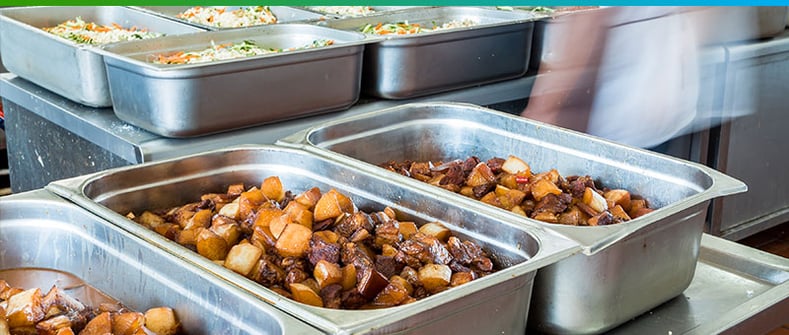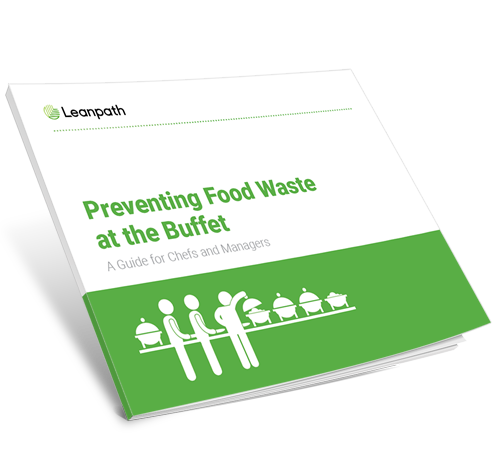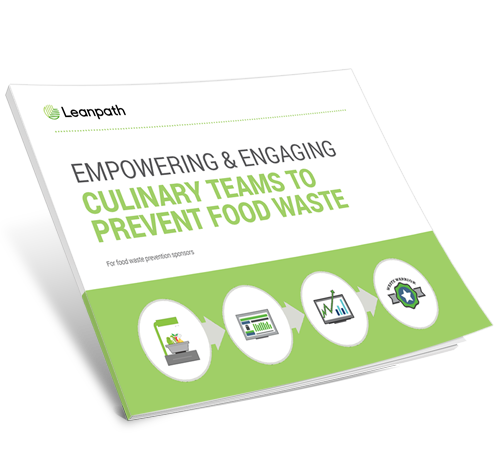Food Waste Intelligence
Subscribe to Food Waste Intelligence
Get our latest posts delivered right to your inbox.

Foodservice operations are often high-intensity, high-pressure environments. There are quotas to meet, quality to uphold, and regulations to comply with. And typically, food waste to contend with—up to 10% of all food purchased goes to waste in the kitchen in many foodservice operations.
How do we balance these many priorities while incorporating a culture of food waste prevention? The first step is to understand why and where waste is occurring. Below are five common factors driving food waste in foodservice operations.
1. Overproduction
Leanpath data has shown that overproduction of food is the leading cause of wasted food in foodservice operations. A lack of visibility into how much of a given food item is often consumed keeps kitchens producing amounts that they believe are appropriate, but are actually more than what is needed. Buffets are a prime source of overproduction. Take control of buffet waste today with our whitepaper: Preventing Food Waste at the Buffet: A Guide for Chefs and Managers.
In foodservice especially, overproduction can be thought of as a risk management tool. It creates a buffer zone for chefs and managers, mitigating the risk of running out of food by making more than required. What we need to remember is that we’re paying for that risk transfer in wasted food.
2. Over-Merchandising
Foodservice operations tend to over-merchandise. Crafting beautiful displays with overflowing vessels creates the appearance of abundance in an effort to increase sales and customer satisfaction. What’s often ignored is its link to increased food waste.
But merchandising doesn’t have to result in wasted food. We can scale back on buffet sizes and slim down customer portions without diminishing value. Creativity is king here: using props, rearranging serving vessels—anything is fair game when rethinking merchandising tactics.
Leanpath customer Boston College used a unique technique with one of their salad bars, cutting pan sizes in half and rearranging them to maintain a very attractive display while reducing the amount of food they needed to produce to fully fill all vessels.
3. Confusing Food Safety Policies
Another food waste driver is protocol around food safety. And while there is absolutely no compromise here – we must serve safe food – it’s important to recognize that confusion around food safety policies can lead to waste, especially in foodservice.
To comply with food safety regulations, operators rightly establish margins of error for food safety. But sometimes, they then create margins of error around those first margins. And perhaps one more margin to be safe. In the pursuit of compliance with food safety policies, operations might be creating waste if they are following rules without applying their own rationale.
And it's time to retire the adage, "When in doubt, throw it out." If kitchen staff are in doubt, they need to ask their manager or food waste champion for direction.
4. False Labor/Waste Trade-Offs
Labor costs in foodservice operations are a hot button issue. Traditionally, managers would attempt to minimize these costs by producing food in large batches, requiring less time investment for staff, who could then clock out earlier. Less labor, more savings.
However, data has shown us that producing large batches of food is inflexible and results in much more waste than small-batch or cook-to-order production. So in trying to save money on labor, operators are actually wasting money, resources, and food when they toss what remains of the big batches at the end of a shift.
5. Customer Choice
Happy customers are critical to success, whether it’s a large foodservice operation or a small restaurant. Conventional wisdom tells us that providing convenient service and a wide array of menu options are two great methods for pleasing customers, but when operations maintain the same service and selection from open to close, waste is created.
Ensuring that the last customer to come through the door receives the same experience as the first one means maintaining the same production amounts and merchandising techniques over the course of an entire day. But why should that expectation be upheld in foodservice? When we visit a fine-dining restaurant at 10:00 at night, we accept the reality that they may have run out of certain menu items. Why not in foodservice environments?
And chances are that if it is explained to a guest your food waste reduction efforts, they will be understanding of any menu change as closing approaches.
How Do I Prevent Food Waste?
The first step to preventing food waste is to identify that you have a problem - and trust us, you probably do. Food waste lurks in every corner of a foodservice operation, from purchasing, to menu design, to service delivery, and now you know the top 5 food waste causes.
We've compiled expert resources to help you get started on your food waste prevention journey; these are quick wins you can implement within your team to start creating a kitchen culture of food waste prevention. When you're ready to get serious about prevention, contact our business development team and we will put together a custom proposal for how you can prevent 50% of your food waste.
Download these guides and get started
on your food waste prevention journey today!
 Preventing Food Waste at the Buffet: A Guide for Chefs & Managers |
 Empowering & Engaging Culinary Teams to Prevent Food Waste |
